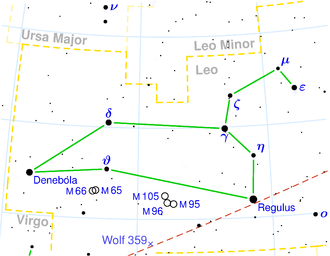IC 663
| Galaxy IC 663 |
|
|---|---|
![IC 663 [1]](https://upload.wikimedia.org/wikipedia/commons/thumb/1/17/IC663_-_SDSS_DR14.jpg/300px-IC663_-_SDSS_DR14.jpg)
|
|
| IC 663 | |
| AladinLite | |
| Constellation | lion |
|
Position equinox : J2000.0 , epoch : J2000.0 |
|
| Right ascension | 11 h 00 m 37.272 s |
| declination | + 10 ° 26 ′ 13.89 ″ |
| Appearance | |
| Morphological type | S0 / Sy 2 |
| Brightness (visual) | 14.4 mag |
| Brightness (B-band) | 15.4 mag |
| Angular expansion | 0.80 ′ × 0.6 ′ |
| Position angle | 175 ° |
| Surface brightness | 13.5 mag / arcmin² |
| Physical data | |
| Affiliation | WBL 296 Abell 1142 |
| Redshift | 0.036108 ± 0.000070 |
| Radial velocity | 10,825 ± 21 km / s |
|
Stroke distance v rad / H 0 |
(479 ± 34) · 10 6 Lj (146.9 ± 10.3) Mpc |
| history | |
| discovery | Edward Swift |
| Discovery date | March 29, 1891 |
| Catalog names | |
| IC 663 • PGC 33182 • CGCG 066-087 • 2MASX J11003725 + 1026137 • GALEX ASC J110037.23 + 102614.8 • NSA 048321 • WISEA J110037.27 + 102613.9 | |
IC 663 is a lens-shaped galaxy of the Hubble type S0 with an active galaxy core in the constellation Leo on the ecliptic . It is an estimated 479 million light years from the Milky Way and about 115,000 light years across.
In the same area of the sky are u. a. the galaxies NGC 3492 , NGC 3506 , IC 664 , IC 666 .
The object was discovered by Edward D. Swift on March 29, 1891 .
